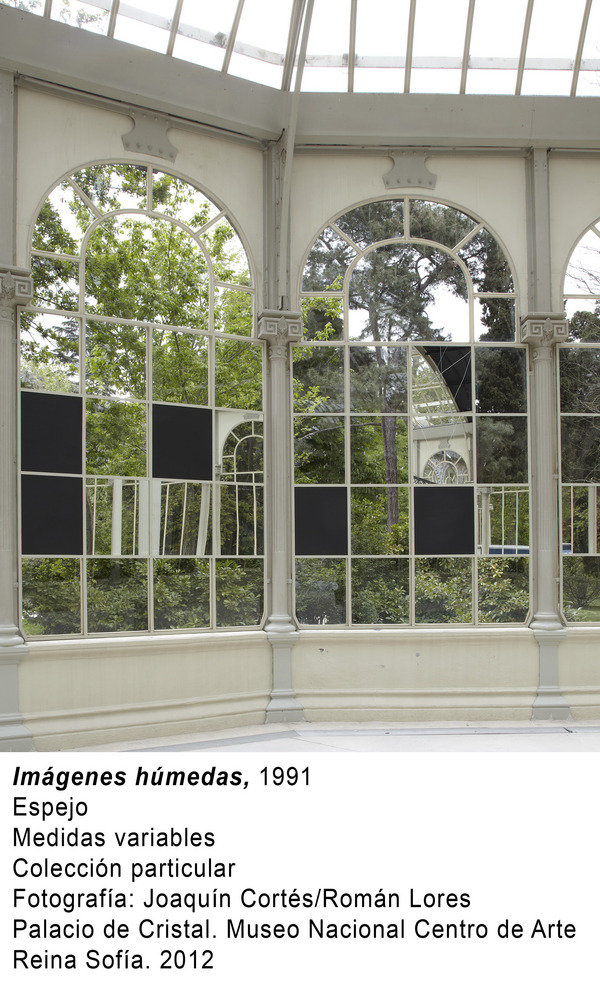Nacho Criado
dal 3/5/2012 al 30/9/2012
Segnalato da
3/5/2012
Nacho Criado
Palacio de Cristal, Madrid
Collaborating Agents. The show spans more than four decades in which Criado used a variety of media to reflect on concepts such as time and transformation, the contrast between idea and matter, the destiny of the artwork as part of a dialectic of construction and destruction, or the meaning of ruins and detritus. The Palacio de Velezquez contains a retrospective selection of his works that reveals his capacity to adopt various practices without ever associating himself with any specific movement or art group. The Palacio de Cristal houses a reconstruction of Piezas de Agua y Cristal, an exhibition that Criado presented in the same space in 1991.

curated by Remo Guidieri
The work of pioneering Spanish experimental artist, Nacho Criado (Mengíbar, Jaén,
1943 – Madrid, 2010), occupies the Reina Sofía Museum’s two venues in the Parque
del Retiro (Retiro Park): the Palacio de Velázquez (Velázquez Palace) and the Palacio
de Cristal (Crystal Palace).
The show spans more than four decades in which Criado used a variety of media
(installation, sculpture, photography, video, architecture) to reflect on concepts such as
time and transformation, the contrast between idea and matter, the destiny of the artwork
as part of a dialectic of construction and destruction, or the meaning of ruins and detritus.
Criado’s work drifts between very different poles but, generally speaking, it is inseparable
from strategies of conceptual art in the broadest sense. Whatever materials were to hand
could became vehicles for discourse: genres such as performance, land art and body art
were not so much labels as research tools for Criado.
The exhibition’s title (Collaborating agents) stems from Criado’s concern with delimiting
the artist’s involvement in the production of his work, and allowing elements in the world
to complete it by acting as “collaborating agents”: atmospheric factors, accidents or
microorganisms. This conviction determined his pieces as living elements: finite as
objects, but unfinished as artworks.
PALACIO DE VELÁZQUEZ
The Palacio de Velázquez contains a retrospective selection of works by Criado that
reveals his capacity to adopt various practices without ever associating himself with any
specific movement or art group. His practice began to take shape within the discourse of
Minimalism that reigned during the second half of the 1960s, responding to its basic
principles in pieces such as those that make up his Homage to Rothko (1970-1994).
In addition, his use of humble materials can be linked to arte povera, which used
industrial materials in its reaction against academic convention. Yet Criado’s practice
focused on process, connecting him directly to another leading figure of modern art —
Marcel Duchamp— to whom he dedicated Prêt-à-porter (MaDe in...) (1976). Duchamp
and other creators to whom he paid homage, or made reference (Bruno Taut, Matthias
Grünewald, Samuel Beckett), were not simply quoted or treated as sources of inspiration.
Drawing on the past, Criado took on the role of a new collaborating agent, reactivating
and updating those artists’ ideas—which remain a part of the history of thought—not as
artworks, but rather as process.
All of these starting points converge in a mature work, It Is Not the Voice That Calls Out
in the Desert (1990), an iron and glass installation that plays a pivotal role in the show.
This work’s title also references another of his interests: the tension between discourse
and silence, destruction and construction. This artwork explores the destiny of all human
organism, which, as part of the dynamics of the biological world, contains the germs of
their own destruction.
PALACIO DE CRISTAL
The second venue, the Palacio de Cristal, houses a reconstruction of Piezas de Agua y
Cristal (Pieces of Water and Glass), an exhibition that Criado presented in the same
space in 1991. That show, which marked the midpoint of his career, bore witness to the
consistency and evolution of his interests. In Umbra Zenobia (1991), the collaborating
agent was the fungus farm he placed on the building’s glass walls; Trasvase (Decanting )
(1991), by contrast, employs glass as a found objet.
This use of broken glass resonated with the space’s architecture while simultaneously
creating a new tension: a work “in a state of ruin”, it contested the Palacio de Cristal’s
utopian architecture. Pieces like Ellos no pueden venir esta noche... (They Cannot
Come Tonight) (1991), or La herida alpina (The Alpine Wound) (1991), constitute an
anti-architecture, designed from conception to be ephemeral, they explored questions
relating to destiny and transformation.
For further information:
PRESS DEPARTMENT
MUSEO REINA SOFÍA
prensa1@museoreinasofia.es
prensa2@museoreinasofia.es
91 774 10 05 / 06
Conference. 14 June, 6 p.m. Sabatini Auditorium.
Palacio de Velázquez and Palacio de Cristal
Parque del Retiro - Madrid



